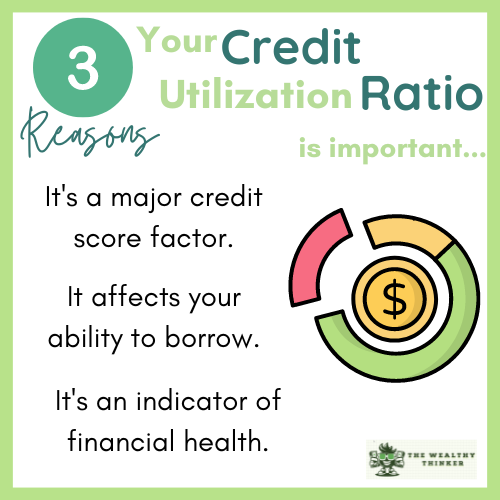Picture this: You’re at a party, and someone brings up credit scores.
Suddenly, the term “credit utilization ratio” gets thrown around. You nod sagely, but inside you’re thinking, “What in the world is that?”
Don’t worry, you’re not alone!
Let’s dive into this financial term that sounds complex but is actually pretty simple – and incredibly important for your financial health.
In simple terms, your credit utilization ratio is the amount of credit you’re using compared to the amount you have available.

What is Credit Utilization Ratio?
In simple terms, your credit utilization ratio is the amount of credit you’re using compared to the amount you have available.
It’s like a financial game of “How close to the edge are you?” But instead of thrills, you’re dealing with your credit score.
Here’s the basic formula: Credit Utilization Ratio = (Total Credit Card Balances / Total Credit Limits) x 100
For example, if you have two credit cards: Card A: $2,000 balance, $5,000 limit Card B: $1,000 balance, $5,000 limit
Your total balance is $3,000, and your total available credit is $10,000. So, your credit utilization ratio would be: ($3,000 / $10,000) x 100 = 30%
Why Should You Care About Your Credit Utilization Ratio?
Now, you might be thinking, “That’s nice, but why does this matter?”
Well, buckle up, because this little percentage packs a big punch when it comes to your credit score.
It’s a Major Factor in Your Credit Score:
Your credit utilization ratio typically accounts for about 30% of your FICO score. That’s huge! It’s second only to payment history in terms of impact.
It’s an Indicator of Financial Health:
Lenders see a low utilization ratio as a sign that you’re managing your credit responsibly. It suggests you’re not overly reliant on credit and can handle your financial obligations.
It Can Affect Your Ability to Borrow:
A high utilization ratio might make lenders nervous about extending you more credit. This could affect everything from credit card applications to mortgage rates.
What’s a Good Credit Utilization Ratio?
Ah, the million-dollar question! While there’s no one-size-fits-all answer, here are some general guidelines:
- Under 30%: Generally considered good
- Under 10%: Excellent – credit score superstars aim for this
- Over 30%: Might start to negatively impact your credit score
- Over 50%: Danger zone – this could significantly hurt your credit score
Remember, lower is always better when it comes to credit utilization.
The Nitty-Gritty: How Credit Utilization is Calculated
Now, let’s get into some details that might surprise you:
It’s Calculated for Each Card and Overall:
Your credit utilization ratio is calculated for each individual card AND across all your cards. So, maxing out one card while leaving others empty isn’t a great strategy.
Timing Matters:
Most credit card issuers report your balance to the credit bureaus once a month, usually on your statement closing date. This means your credit utilization ratio can be high even if you pay your balance in full each month.
Credit Limits Change Things:
If your credit limit increases and your spending stays the same, your utilization ratio will decrease. Conversely, if your limit decreases, your ratio will increase.
6 Strategies to Improve Your Credit Utilization Ratio
Alright, now that you understand what it is and why it matters, let’s talk about how to keep that ratio low and your credit score high:
Pay Down Your Balances:
This one’s obvious but effective. The lower your balances, the lower your utilization ratio.
Make Multiple Payments Each Month:
By making payments before your statement closes, you can keep your reported balance (and thus your utilization ratio) lower.
Ask for a Credit Limit Increase:
If you’ve been a responsible cardholder, your issuer might be willing to increase your limit. Just don’t see this as an excuse to spend more!
Keep Old Credit Cards Open:
Even if you’re not using a card, keeping it open maintains that available credit, which can help your overall utilization ratio.
Use Multiple Cards:
Spreading your spending across multiple cards can help keep individual card utilization low.
Monitor Your Credit Report:
Regularly check your credit report to ensure all information is accurate. Errors in reported balances or credit limits could artificially inflate your utilization ratio.
How to Check Credit Reports for Mistakes & What to Do About Them
Common Credit Utilization Myths Busted
Let’s clear up some misconceptions:
Myth 1: “I pay my balance in full each month, so my utilization doesn’t matter.”
Truth: Your utilization is typically based on your statement balance, regardless of whether you pay in full.
Myth 2: “I should close old credit cards I’m not using.”
Truth: Closing old cards reduces your available credit, which could increase your utilization ratio.
Myth 3: “Using more than 30% of my credit limit will tank my credit score.”
Truth: While staying under 30% is a good rule of thumb, there’s no cliff at 30%. Lower is always better, but going slightly over 30% won’t destroy your credit.
Final Thoughts
Your credit utilization ratio is like a financial vital sign.
It gives lenders a quick snapshot of your credit health and plays a significant role in determining your credit score. By understanding how it works and implementing strategies to keep it low, you’re setting yourself up for better credit scores and more favorable lending terms.
Remember, managing your credit utilization is an ongoing process. It’s not about hitting a magic number once and forgetting about it. It’s about consistently demonstrating responsible credit use over time.
So, the next time someone brings up credit utilization at a party (because that happens all the time, right?), you can confidently join the conversation.
Who knows, you might even become the go-to financial guru in your social circle!
Now go forth and utilize (but don’t over-utilize) your credit wisely!



















